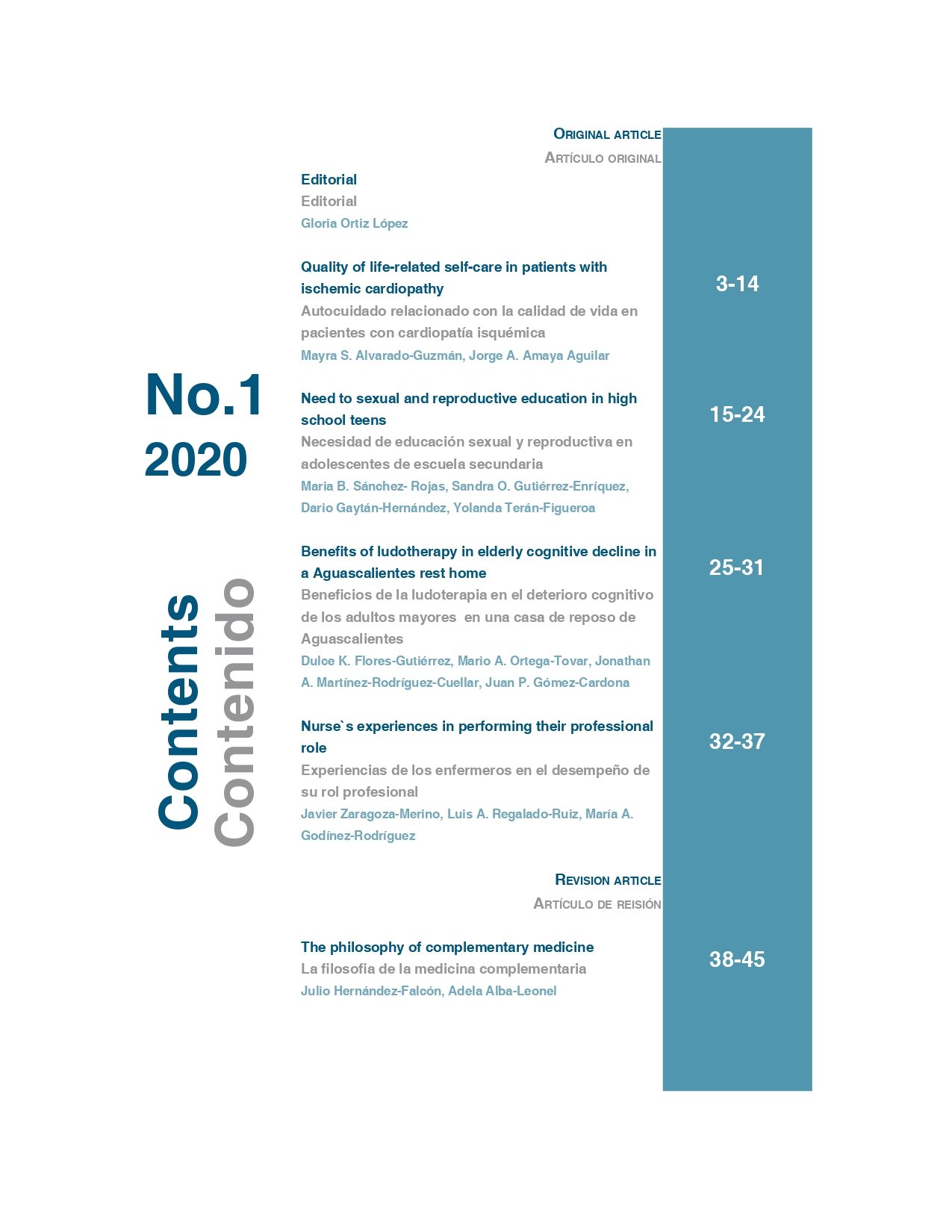Self-care related to quality of life in patients with isqchemic heart diseade
DOI:
https://doi.org/10.51422/ren.v19i1.280Keywords:
self care, quality of life, myocardial infarction, myocardial ischemiaAbstract
Introduction. The patient who suffered acute myocardial infarction (AMI) must adhere to treatment (at), improve their self-care and make lifestyle changes to restore their health; otherwise, there may be an impact on their health-related quality of life (HRQLl).
Objective: to analyze the relationship between self-care and the quality of life of the patient with ischemic heart disease.
Material and methods: correlational, prospective and cross-sectional study. Non-probabilistic sample n = 101 patients selected for convenience; it included adults, both sexes, post AMI. Data collected with questionnaire sf-36; self-care agency scale, biochemical and anthropometric parameters. Data analysis with descriptive statistics and Pearson’s test, significance p <0.05.
Results: age between 34 and 86 years, men predominated (89.1%) and 57.4% had basic education. 39% had high blood pressure and 44% diabetes mellitus ii; 51.5% were overweight and 18.8% were obese. 67.5% depended on their wife, children or both for their care. 93% had the perception of better HRQL, 69% showed good self-care agency and 30% regular. Self-care is correlated with HRQL(r = 0.447, p = 0.000), mainly with the power capacity (r = 0.443, p = 0.000) and the ability to operationalize (r = 0.418, p = 0.000).
Conclusion: by improving the capacity for self-care, the health status of the post-AMI patient is modified and reflected in their quality of life, but the areas of opportunity in matters of secondary prevention and control of risk factors should be reinforced, otherwise there are risks of a new AMI.
Downloads
References
Sánchez-Arias AG, Bonilla-Serrano ME, Dimas-Altamirano B, Gómez-Ortega M, González-González. Enfermedad cardiovascular: primera causa de morbilidad en un hospital de tercer nivel. Rev Mex Cardiol 2016;27(s3):98-102
Resumen de estadísticas de 2017. Enfermedad del corazón y ataque cerebral [Internet]. [place unknown]: American Heart Association; 2017 [citado 26 octubre 2017]. Recuperado a partir de: https://t.ly/211L
Cardiovascular diseases (CVDs) [Internet]. [place unknown]: World Health Organization; 2017 [citado junio 2019]. Recuperado a partir de: https://t.ly/DlC0
Instituto Nacional de Estadística y Geografía (INEGI). Estadísticas de mortalidad 2015 [Internet]. [México]: INEGI; 2015. [citado 24 junio 2017]. Recuperado a partir de: t.ly/rSys
Organization for Economic Co-operation and Development (OECD). OECD Health Statistics 2013 [Internet]. [Paris]: OECD; 2013. [citado 24 junio 2019]. Recuperado a partir de: https://t.ly/9lDE
Achury DM, Sepúlveda GJ, Rodriguez SM. Instrumento para evaluar la capacidad de agencia de autocuidado en pacientes con hipertensión arterial. Inv Enf 2009; 11(2):9-25
Bastidas SC, Olivella FM, Bonilla CI. Significado del autocuidado en la persona que vive con enfermedad coronaria. Sal Uninorte 2015;31(1):78-90
Niquille A, Bugnon O. Relationship between drug-related problems and health outcomes: a cross-sectional study among cardiovascular patients. Pharm World Sci 2010;32(4):512-9
Sillas DG, Jordán LJ. Autocuidado, elemento esencial en la práctica de enfermería. Desarrollo Científ Enferm 2011;19(2):67-9
Rivera AL. Capacidad de agencia de autocuidado en personas con hipertensión arterial hospitalizadas en una Clínica de Bogotá, Colombia. Rev Salud Púb 2006;5(3):235-47
Leiva VD, Cubillo KV, Porras YG, Ramírez TV, Sirias IW. Validación de apariencia, contenido y consistencia interna de la escala de apreciación de agencia de autocuidado (ASA) para Costa Rica, segunda versión en español. Rev Enferm Actual Costa Rica 2015; 29:1-14
Mantilla ST, Gómez- Conesa A. Internacional de actividad física. Un instrumento adecuado en el seguimiento de la actividad física poblacional. Rev Iberoam Fisioter Kinesol 2007;10(1):48-52
Vllagut G, Ferrer M, Rajmll L, Rebollo P, Permanyer-Miralda G. El cuestionario de salud SF-36 español: una década de experiencia y nuevos desarrollos. Gac Sanit. 2005;19(2):135-50
Lugo LA, García HG, Gómez CR. Confiabilidad del cuestionario de calidad de vida en salud sf-36 en Medellín, Colombia. Rev Fac Nac Sal Púb 2005;24(2):37-50
Romero EM. Confiabilidad del cuestionario de salud SF-36 en paciente post-infarto agudo del miocardio procedente de Cartagena de Indias, Colombia. Rev Colomb Cardiol 2008; 17(2): 41-6
Sánchez RA, García MM, Martínez DT. Encuesta de Salud SF-36: validación en tres contextos culturales de México. Rev Iberoam Diagn EV 2017;45(3):5-16
Franco SA, Cardona-Arango D. Calidad de vida de pacientes con enfermedad cardiovascular en un programa de seguimiento farmacoterapéutico. Rev Méd Risaralda 2017;23 (1):30-3
Navarro JC. Epistemología y metodología. México: Grupo Editorial Patria; 2014. 575-85
Secretaría de Gobernación [Internet]. Norma Oficial Mexicana NOM-012-SSA3-2012, que establece los criterios para la ejecución de proyectos de investigación para la salud en seres humanos. 5 de noviembre de 2009; Diario Oficial de la Federación. [Citada 26 junio 2018]. Disponible: https://t.ly/qr4S
CONAMED Declaración de Helsisnky [Internet]. México: Comisión Nacional de Bioética; [Citada 26 junio 2018]. Disponible: https://t.ly/qdIk
Comité de Bioética de México [Internet]. Código de Núremberg; [Citada 2018 26 junio 2018]. Disponible: https://t.ly/Bx8w
Comité de Bioética de México [Internet]. Informe de Belmont; [Citada 26 junio 2018]. Disponible: https://t.ly/5dnh
Secretaría de Gobernación [Internet]. Norma Oficial Mexicana NOM-004-SSA3-2012, del expediente clínico. 5 octubre 2010; Diario Oficial de la Federación. [Citada 26 junio 2018]. Disponible: https://t.ly/K6FI
Rojas-Reyes J, Flórez-Flórez ML. Adherencia al tratamiento y calidad de vida en personas con infarto agudo de miocardio. Aquichan 2016;16(3):328-39. Doi: https://doi.org/10.5294/aqui.2016.16.3.5
Schweikert B, Hunger M, Meisinger C, Konig H-H, Gapp O, Holle R. Quality of life several years after myocardial infarction: comparing the MONICA/KORA registry to the general population. Eur Heart J 2008; 30(4):436-43
Corrales-Santander H, Manzur-Jattin F, Pacheco-Ayo C. Enfermedad coronaria en el paciente con diabetes mellitus tipo 2. Archi Méd 2018; 14:1-3
Jiwani RB, Cleveland LM, Patel DI, Virani SS, Gill SL. Understanding self-regulation behaviors in South Asians with coronary artery disease a mixed-methods study. J Cardiovasc Nurs 2016;1-7
Barrantes-Morales F, Salas-Segura D. Sobrevida y calidad de vida de los pacientes con cardiopatía isquémica egresados de una unidad de cuidados intensivos de tercer nivel. Rev Costarric Cardiol 2016;18(1-2):13-5
Nampulá M, Sosa M. Experiencias de hombres con cardiopatía isquémica a un año de egreso hospitalario. Rev Mex Enf Cardiol 2018; 26(3):70-5






